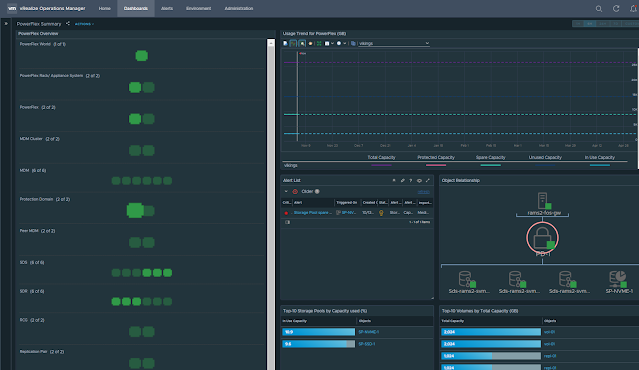In this post, we will take a look at the different resource kinds that are part of the Dell EMC PowerFlex Management Pack. Following is a very high-level logical representation of the PowerFlex Adapter resource kinds and their relationships:
Sunday, November 8, 2020
Dell EMC PowerFlex MP for vROps 8.x - Part4 - Resource kinds and relationships
Part1 - Install
Wednesday, November 4, 2020
Dell EMC PowerFlex MP for vROps 8.x - Part3 - Dashboards
- PowerFlex System Overview
- PowerFlex Manager Details
- PowerFlex Management Controller
- PowerFlex ESXi Cluster Usage
- PowerFlex ESXi Host Usage
- PowerFlex SVM Utilization
- PowerFlex Networking Environment
- PowerFlex Networking Performance
- PowerFlex Summary
- PowerFlex Details
- PowerFlex Replication Details
- PowerFlex Node Summary
- PowerFlex Node Details
PowerFlex Node Summary
PowerFlex Summary
References
Monday, November 2, 2020
Dell EMC PowerFlex MP for vROps 8.x - Part2 - Configure
In this post, I will explain how to configure the PowerFlex Management Pack for vROps.
Before getting into the configuration, I would like to provide a high-level view of my lab setup. I have two separate PowerFlex rack systems that I will be monitoring using the management pack. The two systems are named RAMS and VIKINGS and have the following components.
- PowerFlex Networking - queries and collects networking details from Cisco switches
- PowerFlex Gateway - queries and collects storage details from PowerFlex Gateway
- PowerFlex Nodes - queries and collects server hardware health details from iDRACs
- PowerFlex Manager - queries and collects service deployment details from PowerFlex Manager
PowerFlex Networking
Let's configure the account for monitoring Cisco TOR switches of the RAMS cluster.
Provide the following details:
- Name
- Management IP address of Cisco TOR switches
Select the instance type as "PowerFlex Networking" and provide a system name.
In this case, these TOR switches are part of RAMS. So I have given the system name as RAMS.
Click ADD to save the account. You will see the account we just created under the other accounts page.
Initially, the status will be warning but it will turn to OK in few seconds.
PowerFlex Gateway
PowerFlex Nodes
PowerFlex Manager
References
Friday, October 30, 2020
Dell EMC PowerFlex MP for vROps 8.x - Part1 - Install
Related posts
Part2 - Configure
Part3 - Dashboards
Part4 - Resource kinds and relationships
References
Sunday, September 27, 2020
Monitoring Tanzu Kubernetes cluster using Prometheus and Grafana
Updated: June 26, 2021
In this post, we will see how to deploy Prometheus and Grafana using Helm and Prometheus Operator to monitor Tanzu Kubernetes clusters.
The default username is "admin" and the password is "prom-operator".
References
https://github.com/prometheus-community/helm-charts/tree/main/charts/kube-prometheus-stack
[www.bogotobogo.com] Docker_Kubernetes_Prometheus_Deploy_using_Helm_and_Prometheus_Operator
Saturday, September 19, 2020
Performance monitoring in Linux
CPU
cd /proc/
cat cpuinfo
less cpuinfo
less cpuinfo | grep processor
uptime
The load average is the CPU usage load average over 1 min, 5 min, and 15 min. The calculation for load avg value is given below.
For a single processor system:
Load avg value 1.0 = 100% CPU capacity usage
Load avg value 0.5 = 50% CPU capacity usage
This means for a 4 processor system:
Load avg value 4.0 = 100% CPU capacity usage
Load avg value 2.0 = 50% CPU capacity usage
Load avg value 1.0 = 25% CPU capacity usage
top
To get details of a process: ps aux | grep <process ID>
To get logs of a process: journalctl _PID=<process ID>
Memory
Average memory usage view by samples with regular intervals:
vmstat <interval> <number of samples>
Hope it was useful. Cheers!












































